7 Epic Ways to Experience the Whale Season Big Island (2025)
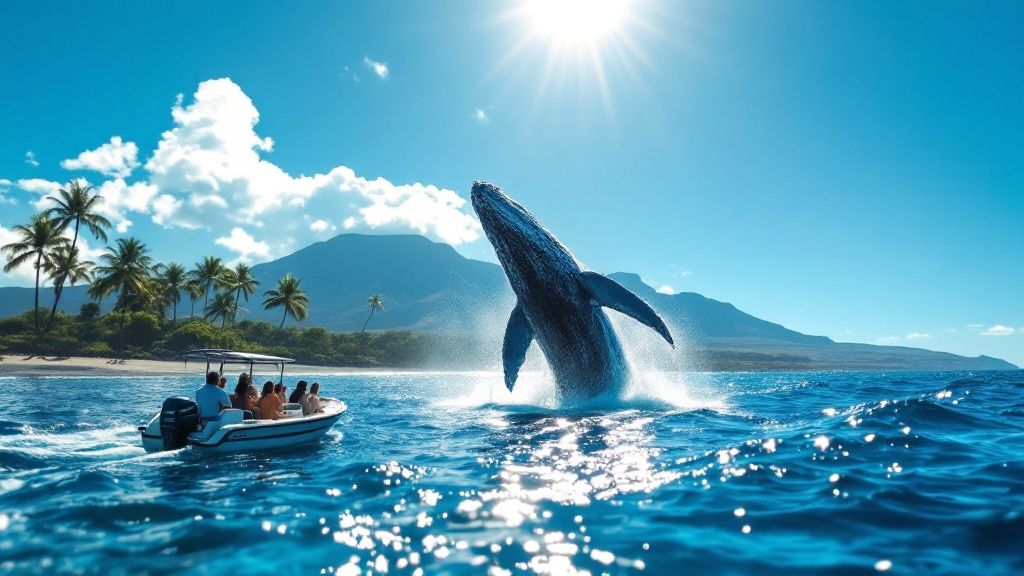
Welcome to the Big Island, where the ocean comes alive each winter! The annual migration of humpback whales transforms the Hawaiian waters into a breathtaking spectacle of breaches, tail slaps, and spouts. Understanding the whale season Big Island offers is the key to witnessing these gentle giants up close. The best time of year to see whales is typically mid-December through the end of March, when thousands of humpback whales travel to the warm, protected waters around the island to breed, give birth, and nurse their young. This guide provides seven incredible ways to experience this natural wonder, from thrilling boat tours to serene shoreline viewing spots. We'll explore the best times, essential tips, and top-rated options, including those from Kona Snorkel Trips, the top-rated & most reviewed snorkel company in Hawaii. Let's dive into making your whale watching Big Island adventure unforgettable.
1. Embark on a Premier Kohala Coast Whale Watching Tour
The calm, protected waters of the Kohala Coast on the Big Island’s northwest side are a world-renowned sanctuary for humpback whales. During the peak whale season Big Island experiences from mid-December through the end of March, this area boasts one of the highest densities of these marine mammals, making it the premier destination for whale watching. Tour operators departing from Kawaihae and Honokohau Harbors offer unparalleled access to witness breaching, tail slapping, and other spectacular behaviors in their natural habitat.
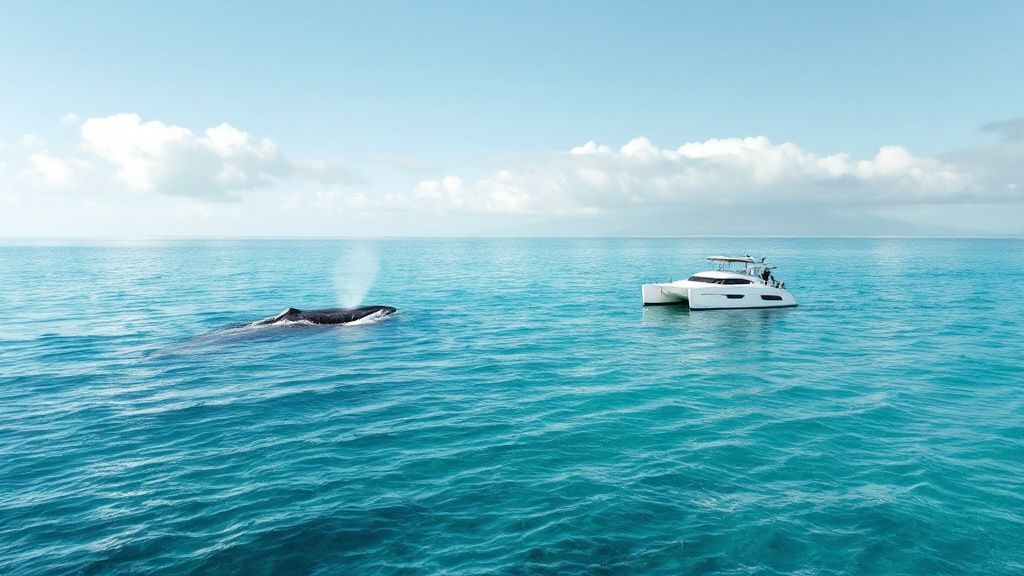
Why Choose a Guided Tour?
Opting for a guided tour significantly increases your chances of memorable encounters. Experienced captains and naturalists know the whales' patterns and use hydrophones to listen for their songs, guiding you to the most active spots. For those looking for an exceptional Big Island whale watching experience, combining two of Hawaii's most incredible marine encounters is possible with Kona Snorkel Trips' Manta & Whale Watching tour.
To compare different vessels and itineraries, you can review comprehensive guides like the list of the Top 5 Whale Watching Kona Big Island Tours from Kona Honu Divers.
Practical Tips for Your Trip
- Book in Advance: Tours fill up quickly, especially during peak season. Reserve your spot 2 to 4 weeks ahead of time.
- Best Time to Go: Morning departures (7-9 a.m.) typically offer the calmest sea conditions for a smoother ride.
- What to Bring: Polarized sunglasses are essential for cutting through the ocean glare to spot whales. Also, pack layered clothing, reef-safe sunscreen, and a hat. If you're prone to seasickness, take medication about 30 minutes before your tour.
By joining one of the many whale watching Big Island tours, you'll gain a deeper appreciation for these magnificent creatures.
2. Puukohola Heiau National Historic Site Shore Watching
For those who prefer to keep their feet on solid ground, the Puukohola Heiau National Historic Site offers one of Hawaii's best land-based whale watching opportunities. Perched above the calm waters near Kawaihae, this elevated vantage point provides a sweeping panoramic view of the Hawaiian Islands Humpback Whale National Marine Sanctuary. It's an ideal spot for visitors to witness the awe-inspiring behaviors of humpback whales without setting sail, making it a perfect activity for families and budget-conscious travelers during the whale season Big Island.
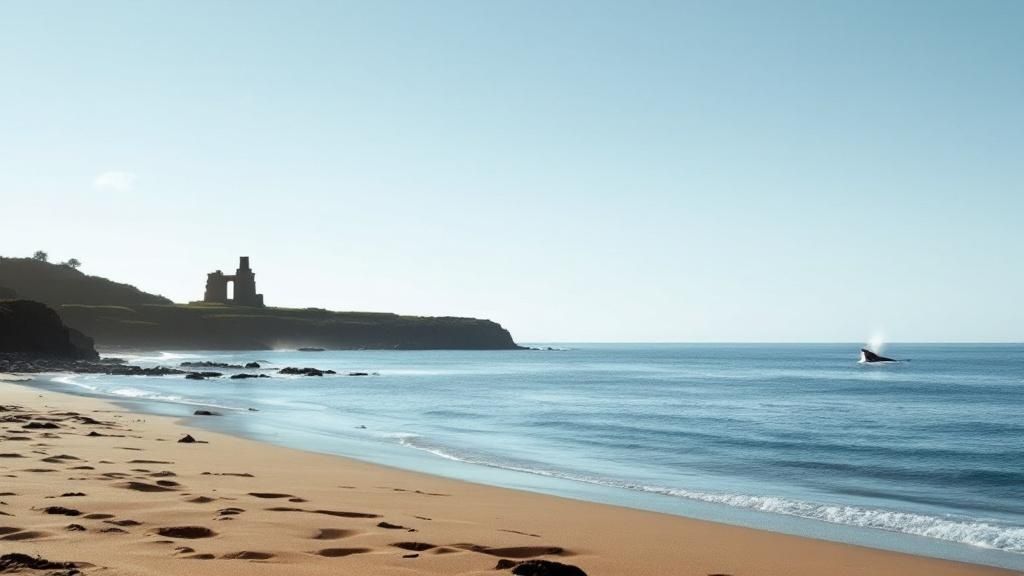
Why Choose Shore-Based Viewing?
This historic site combines a deep cultural experience with spectacular natural phenomena. Park rangers often give talks during peak season, and the annual "Whale Day" celebration in February adds an educational layer to your viewing. You can experience the thrill of spotting a breach or tail slap from a stable, serene environment, free from the cost of a boat tour. Those looking to combine this cultural landmark with other sightseeing adventures can explore options like a wildlife watching and historical sightseeing tour to fully appreciate the area's significance.
Practical Tips for Your Visit
- Bring Binoculars: This is the most crucial tip. Binoculars or a spotting scope are essential for getting a clear view of the whales from shore.
- Best Time to Visit: Whales are often more active closer to shore between 9 a.m. and 2 p.m. Look for the distinct white puff of a whale's spout on the horizon.
- What to Pack: The area is exposed and can be hot. Bring plenty of water, reef-safe sunscreen, a hat, and snacks. You can easily combine your visit with a trip to the nearby Spencer Beach Park.
3. Mauna Kea Beach and Hapuna Beach Shore Watching
For those who prefer to keep their feet on solid ground, the world-renowned white sands of Mauna Kea and Hapuna Beaches offer some of the best land-based whale watching on the Big Island. Located along the sun-drenched Kohala Coast, these adjacent beaches provide elevated vantage points and clear, expansive ocean views. During the peak whale season Big Island months, it's not uncommon to witness the majestic arc of a breaching humpback or the powerful spray from a blowhole, all from the comfort of your beach towel.
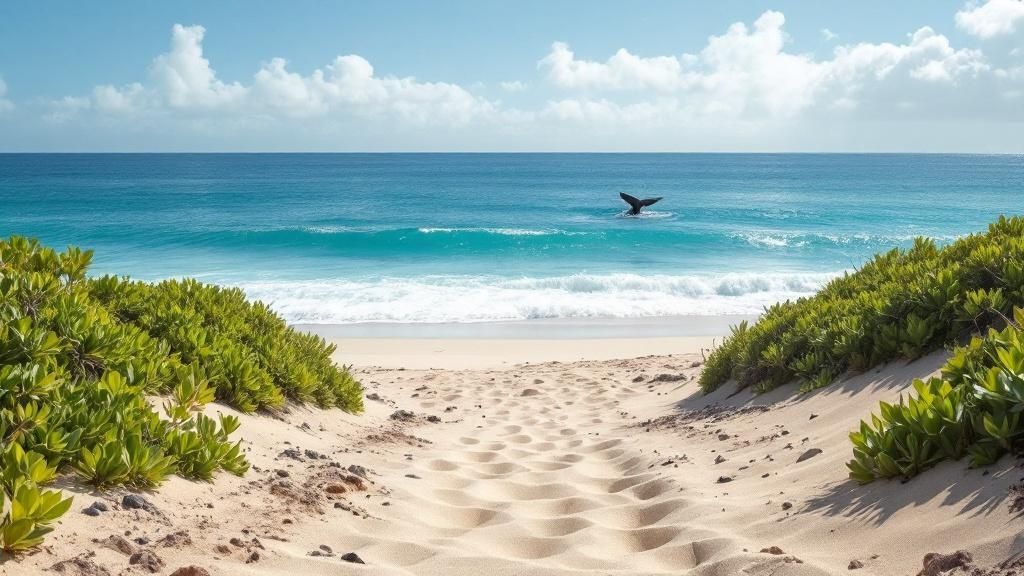
Why Choose Shore Watching?
Shore watching provides a relaxed and flexible alternative to boat tours, perfect for families with young children or anyone prone to seasickness. The Mauna Kea Beach Hotel and Hapuna Beach State Park are famous for their beauty and accessibility, often featuring educational stations during the season. This method allows you to combine a classic beach day with the thrill of spotting whales, making for a uniquely Hawaiian experience without the commitment of a scheduled tour. The panoramic scenery and tranquil environment create an ideal setting for patient observation.
Practical Tips for Your Trip
- Arrive Early: Parking at both beaches, especially Hapuna, can fill up quickly. Arrive before 9 a.m. to secure a spot.
- Gain Elevation: Use the elevated walkways and access points near the beach entrances for a better, wider view of the ocean horizon.
- Bring Binoculars: A good pair of binoculars is your best tool for shore-based viewing, allowing you to see distant activity in detail.
- Scan Systematically: Patiently scan the horizon from one end to the other, looking for disruptions on the water's surface like splashes or spouts.
4. Hilo Bay and Downtown Hilo Waterfront Whale Watching
While the Kohala Coast gets most of the attention, the protected waters of Hilo Bay on the island’s windward side offer an often-overlooked and accessible whale watching experience. During the peak whale season Big Island months, humpbacks can be spotted from various points along the downtown waterfront. This provides a fantastic, free alternative to boat tours, allowing you to enjoy the spectacle at your own pace while exploring the historic and lush Hilo area.
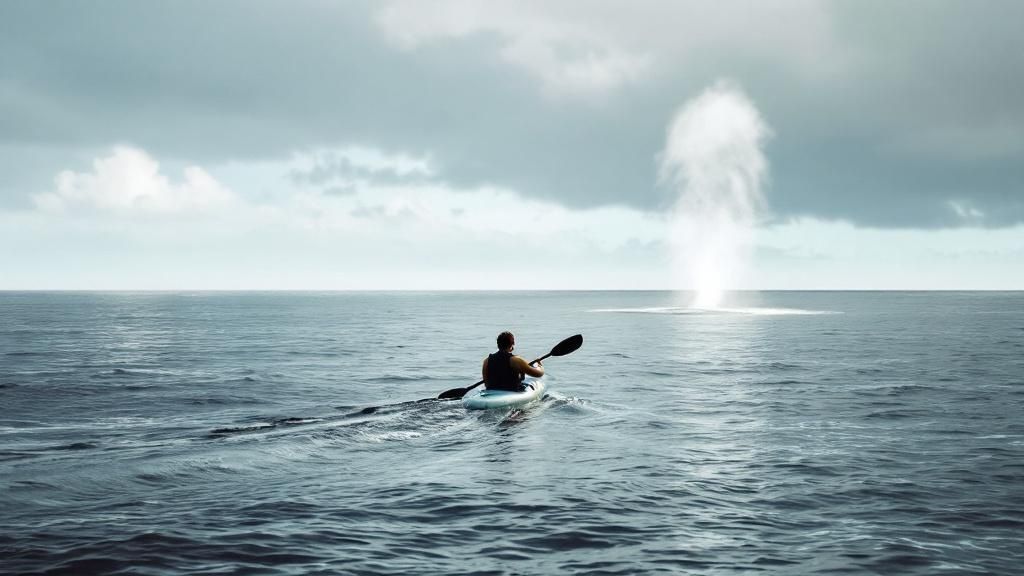
Why Choose Shoreline Viewing in Hilo?
Shore-based viewing in Hilo is ideal for those who prefer to stay on land, are on a budget, or wish to combine whale watching with cultural activities. Locations like Coconut Island (Moku Ola) and the trails around Liliʻuokalani Gardens offer panoramic ocean views perfect for spotting breaches and spouts. This approach offers flexibility and a different perspective on the Big Island whale watching phenomenon, deeply integrated with the local community life.
Practical Tips for Your Trip
- Best Viewing Spots: Walk across the footbridge to Coconut Island for 360-degree views or stroll the Hilo Bayfront Trail for multiple vantage points.
- Best Time to Go: Early mornings typically provide the clearest skies and calmest waters before the common afternoon clouds and rain showers move in.
- What to Bring: Binoculars are a must for getting a closer look at the whales. Also, pack a rain jacket, as Hilo's weather can change quickly, even on a sunny day. Combine your visit with a trip to the Hilo Farmers Market or the Pacific Tsunami Museum.
5. Captain Dan McSweeney's Whale Watch Learning Adventures
For those seeking an experience beyond a standard tour, Captain Dan McSweeney's Whale Watch Learning Adventures offers an educational deep-dive into the world of humpback whales. Led by a marine mammal researcher with over 30 years of experience studying Big Island's cetaceans, these expeditions are essentially floating classrooms. The focus is on the scientific aspects of whale behavior, biology, and conservation, providing a unique perspective often featured in National Geographic and BBC wildlife documentaries.
Why Choose an Educational Tour?
Opting for an educational tour transforms your outing from passive observation into active learning. Captain Dan provides real-time commentary based on decades of research, explaining the nuances of whale communication and social structures. This approach offers a richer appreciation for the complexities of marine life during the whale season Big Island hosts. His work has contributed directly to NOAA's whale population studies, ensuring the information you receive is both accurate and impactful. You can learn more about Captain Dan McSweeney's Whale Watch Learning Adventures and other specialized tour options.
Practical Tips for Your Trip
- Book Far in Advance: Due to its niche appeal and small group size, tours sell out quickly. Reserve your spot 4 to 8 weeks ahead, especially for February and March.
- Come Prepared to Learn: Bring a notepad and don't be shy about asking questions. Captain Dan encourages an interactive environment.
- What to Bring: A camera with a good telephoto lens is crucial for capturing detailed photos. Also pack polarized sunglasses, a hat, and reef-safe sunscreen. Reading his whale identification guide beforehand can greatly enhance your experience.
6. Participate in the Hawaii Island Humpback Whale Count
For a truly immersive and meaningful experience during the Big Island whale season, consider volunteering for the Great Whale Count. This citizen science program, organized by the Hawaiian Islands Humpback Whale National Marine Sanctuary, allows residents and visitors to contribute directly to whale conservation. By stationing yourself at designated shoreline locations, you can help researchers monitor humpback whale populations, providing data that tracks recovery trends and informs conservation policies.
Why Choose to Volunteer?
This free program offers a unique opportunity to go beyond simple observation and play an active role in protecting these magnificent creatures. Data collected by volunteers is integrated into official studies by NOAA, contributing to the understanding of North Pacific humpback populations. It’s an educational and rewarding way to spend a day, connecting with both the whales and a community of fellow ocean enthusiasts, making your whale watching Big Island adventure even more impactful.
Practical Tips for Your Count Day
- Register Early: Sign up online through the sanctuary's website at least a week in advance, as popular stations fill up quickly.
- Be Prepared: Bring binoculars for better viewing, along with reef-safe sunscreen, water, snacks, and a hat. Dress in layers to adapt to changing coastal weather.
- Arrive on Time: Get to your assigned station about 15 minutes early to receive a brief orientation and training from the site leader.
This program offers a unique perspective on the annual whale migration and is an excellent complement to professional Big Island whale watching tours.
7. South Kona Coast Kayak Whale Watching
For a more intimate and adventurous encounter, sea kayaking along the South Kona Coast offers an unparalleled, paddle-powered perspective on the whale season Big Island. Paddling the calm waters from Kealakekua Bay toward Honaunau Bay allows you to experience the awe of humpback whales from sea level, combining a great workout with incredible wildlife observation. This low-impact approach respects the whales' natural environment while you explore a historically significant and beautiful coastline.
Why Choose a Kayak?
Kayaking provides a quiet, personal experience that motorized vessels cannot replicate. You can hear the whales' powerful breaths and the splash of their tails without the sound of an engine. Reputable operators like Adventures in Paradise and Kona Boys offer guided tours, providing both safety and local knowledge. Self-guided paddlers often launch from Napoopoo Beach Park, but this is recommended only for those with significant ocean kayaking experience.
This method of whale watching Hawaii Big Island is ideal for active travelers who want to feel more connected to the ocean environment.
Practical Tips for Your Trip
- Book an Early Tour: Morning trips typically offer calmer seas and more active whale behavior.
- Physical Preparedness: Be ready for a paddle of three or more miles. Building upper body strength beforehand is beneficial.
- What to Bring: A waterproof camera or GoPro can capture stunning, eye-level footage. Wear a long-sleeve rash guard, a hat, and plenty of reef-safe sunscreen.
- Safety First: If whales approach, federal law requires you to stop paddling and maintain a safe distance, letting them pass. Always check ocean forecasts before heading out.
7 Key Resources Comparison for Big Island Whale Season
| Experience | Core Features / Highlights | User Experience ★ | Value & Price 💰 | Target Audience 👥 | Unique Selling Points ✨ |
|---|---|---|---|---|---|
| Kohala Coast Whale Watching Tours | Peak whale season, multiple vessel types, guided tours | ★★★★☆ High success & calm seas | $80-$150 per adult | Whale watchers, families | Marine biologist narration, calm leeward waters 🏆 |
| Puukohola Heiau Shore Watching | Free shore viewing, cultural historic site, ranger-led | ★★★☆☆ Educational & accessible | Free | Budget & culture seekers | Combines whale watching with Hawaiian cultural history ✨ |
| Mauna Kea & Hapuna Beach Watching | Beach amenities, elevated views, family-friendly | ★★★★☆ Clear waters, beach combo | Free-$10 parking | Families, beach lovers | World-class beaches with whale spotting opportunity ✨ |
| Hilo Bay & Downtown Hilo | Free waterfront points, downtown access, protected bay | ★★★☆☆ Casual, less crowded | Free | Casual observers, tourists | Combining city visit + whale watching, easy access |
| Captain Dan McSweeney's Tours | PhD marine biologist-led, small groups, year-round | ★★★★★ Expert education & personal | $125-$150 per person | Serious whale watchers, learners | Only Big Island biologist-led tour, research contribution 🏆 |
| Humpback Whale Count Volunteer | Citizen science, free, data collection, training | ★★★★☆ Educational, participatory | Free | Families, volunteers, students | Official NOAA program, contribute to science ✨ |
| South Kona Coast Kayak Whale Tours | Guided/self-guided kayak, snorkeling, eco-friendly | ★★★★☆ Intimate & active | $89-$140 guided, rentals $25-$75 | Adventure seekers, fitness buffs | Close water-level whale watching, low-impact adventure ✨ |
Booking Your Unforgettable Big Island Whale Encounter
The annual humpback migration transforms the waters off the Big Island into a vibrant stage for one of nature’s most awe-inspiring performances. Throughout this guide, we've explored the diverse ways you can experience the whale season Big Island offers, from the serene shores of Puukohola Heiau and Mauna Kea Beach to the adventurous kayak routes along the South Kona coast. We've highlighted the value of citizen science with the Great Whale Count and the educational depth offered by specialized learning adventures. Each option provides a unique perspective on these magnificent creatures and their behaviors, from the powerful breach to the tender interactions between a mother and her calf.
Understanding the peak season, from mid-December through the end of March, is your first step to maximizing your chances of a truly profound encounter. The most critical takeaway is that responsible viewing is paramount. Whether you're on land with binoculars or on the water with a certified tour operator, respecting the whales' space ensures their safety and the preservation of this incredible natural cycle for years to come. The power of a successful whale watching experience lies not just in what you see, but in the connection you feel to the vast marine ecosystem.
For those ready to move from shoreline spectator to active participant, booking a professionally guided tour is the most effective and respectful way to get closer to the action. An expert crew can interpret whale behavior, use hydrophones to let you hear their songs, and navigate to the best viewing spots safely and legally. This is your opportunity to turn a vacation into a transformative experience, creating memories that resonate long after you've returned home. The whale watching Kona Big Island provides is a world-class adventure, and planning ahead ensures you don’t miss out. With the right approach, your Big Island whale watching tour will become the highlight of your Hawaiian journey, a powerful reminder of the wild beauty our planet holds.
Ready to witness the magic firsthand? For a top-rated, intimate, and eco-conscious adventure on the water, look no further than Kona Snorkel Trips. Their expert-led Big Island whale watching tours are designed to provide unforgettable encounters during the peak whale season. Book your tour with Kona Snorkel Trips today and secure your front-row seat to one of the greatest shows on Earth.
